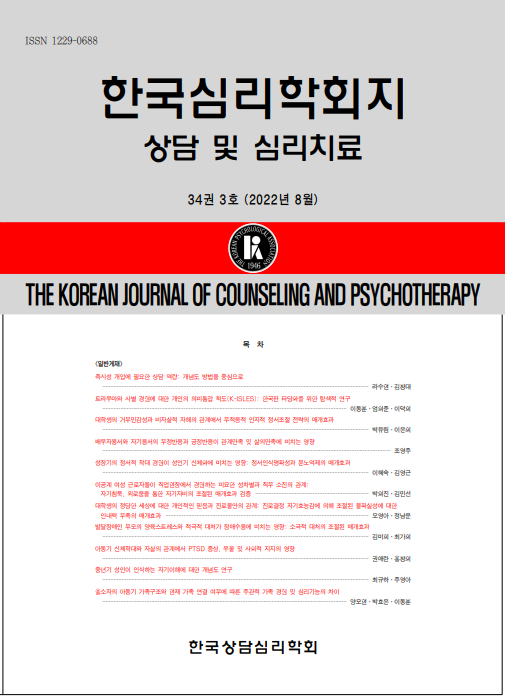open access
메뉴
open access
메뉴 ISSN : 1229-0688
ISSN : 1229-0688
본 연구는 한국의 청소년 상담실과 대학 상담 기관의 상담원 46명을 대상으로 소진과 관련된 경험을 기술하게 하여 그 내용을 질적 분석하였다. 그 결과 상담자들이 겪는 일반적인 소진의 문제는 기관, 상담자, 내담자, 사회적 인식 등에서 비롯되고 신체적 문제, 부정적 정서, 무의미감, 회의 등을 경험하지만 이를 자각하고 자신의 결점 보완과 자기 개발의 노력도 함께 이루어지는 것으로 나타났다. 대학 상담실보다는 청소년 상담기관에서 상담외 업무, 관료체제, 상사 및 동료와의 갈등, 개인적 네트워크 부재, 상담절차상의 문제, 업무에 대한 부정적 태도 등이 뚜렷이 경험되고 대학상담실 근무자들은 상담자 자신의 미해결문제 중 역전이, 정서적 감염, 내담자의 저항 등 상담관계에서 오는 소진 경험이 많은 것으로 나타났다. 경력별 소진의 차이를 보면 초심자의 경우 근무 기관에서 오는 소진은 실제적인 업무 내용과 관련되어 있고 물리적 환경, 전문추수 교육 부족, 개인적 문제나 내담자와의 관계에서 오는 문제, 낮은 보수나 취업, 진로와 관련된 비젼 부족과 관련되었다. 경력자들은 기관내의 인간관계나 관료적 체계 등에서의 심리적인 부분과, 자기개발 여유 부족, 가정에서의 역할 갈등, 상담 개입의 한계에서 소진이 경험되는 것으로 나타났다.
The purpose of this study is to analyze the process by which professional psychotherapists in Korea become overwhelmed and overworked as a result of their cases. A cohort of forty-six such counselors who work in either established community or university counseling centers participated in this systematic investigation of the burnout phenomenon. The counselors' burnout experiences were recorded and subsequently analyzed in both a qualitative and quantitative fashion in order to define the integral causes and ramifications of such experiences. The research results include the following: (1) The causes and ramifications of the burnout phenomenon can be schematized into five overarching domains and thirty-four sub-categories of classification. (2) There exist distinct differences between the burnout experiences related by counselors from community counseling centers versus their counterparts at university counseling centers. (3) The fundamental causes of burnout precipitation include problems with the center's bureaucracy, conflicts with bosses & co-workers, support networks that are inadequate support networks, counseling protocols that are objectionable, and counter-transference issues. (4) Significant burnout differences also appear between novices and experts, whereby novice counselors are particularly affected by issues unrelated to counseling, such as the physical working environment, lack of monetary and educational opportunities, problems from client relationships, and conflicts between professional expectations for them by members of the center versus members of their family.
